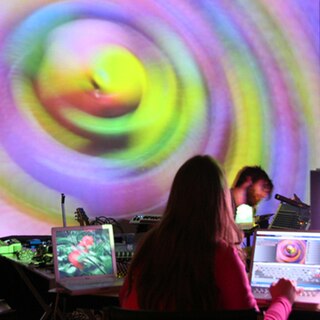Related Research Articles
Video art is an art form which relies on using video technology as a visual and audio medium. Video art emerged during the late 1960s as new consumer video technology such as video tape recorders became available outside corporate broadcasting. Video art can take many forms: recordings that are broadcast; installations viewed in galleries or museums; works streamed online, distributed as video tapes, or DVDs; and performances which may incorporate one or more television sets, video monitors, and projections, displaying live or recorded images and sounds.

Installation art is an artistic genre of three-dimensional works that are often site-specific and designed to transform the perception of a space. Generally, the term is applied to interior spaces, whereas exterior interventions are often called public art, land art or art intervention; however, the boundaries between these terms overlap.
Eija-Liisa Ahtila is a contemporary visual artist and filmmaker who lives and works in Helsinki.

David Hall was an English artist, whose pioneering work contributed much to establishing video as an art form.

Gary Hill is an American artist who lives and works in Seattle, Washington. Often viewed as one of the foundational artists in video art, based on the single-channel work and video- and sound-based installations of the 1970s and 1980s, he in fact began working in metal sculpture in the late 1960s. Today he is best known for internationally exhibited installations and performance art, concerned as much with innovative language as with technology, and for continuing work in a broad range of media. His longtime work with intermedia explores an array of issues ranging from the physicality of language, synesthesia and perceptual conundrums to ontological space and viewer interactivity. The recipient of many awards, his influential work has been exhibited in most major contemporary art museums worldwide.
Video installation is a contemporary art form that combines video technology with installation art, making use of all aspects of the surrounding environment to affect the audience. Tracing its origins to the birth of video art in the 1970s, it has increased in popularity as digital video production technology has become more readily accessible. Today, video installation is ubiquitous and visible in a range of environments—from galleries and museums to an expanded field that includes site-specific work in urban or industrial landscapes. Popular formats include monitor work, projection, and performance. The only requirements are electricity and darkness.

Shigeko Kubota was a Japanese video artist, sculptor and avant-garde performance artist, who mostly lived in New York City. She was one of the first artists to adopt the portable video camera Sony Portapak in 1970, likening it to a "new paintbrush." Kubota is known for constructing sculptural installations with a strong DIY aesthetic, which include sculptures with embedded monitors playing her original videos. She was a key member and influence on Fluxus, the international group of avant-garde artists centered on George Maciunas, having been involved with the group since witnessing John Cage perform in Tokyo in 1962 and subsequently moving to New York in 1964. She was closely associated with George Brecht, Jackson Mac Low, John Cage, Joe Jones, Nam June Paik, and Ay-O, among other members of Fluxus. Kubota was deemed "Vice Chairman" of the Fluxus Organization by Maciunas.

Tony Oursler is an American multimedia and installation artist. He completed a Bachelor of Fine Arts at the California Institute for the Arts, Valencia, California in 1979. His art covers a range of mediums, working with video, sculpture, installation, performance, and painting. The artist currently lives and works in New York City.

VJing is a broad designation for realtime visual performance. Characteristics of VJing are the creation or manipulation of imagery in realtime through technological mediation and for an audience, in synchronization to music. VJing often takes place at events such as concerts, nightclubs, music festivals and sometimes in combination with other performative arts. This results in a live multimedia performance that can include music, actors and dancers. The term VJing became popular in its association with MTV's Video Jockey but its origins date back to the New York club scene of the 70s. In both situations VJing is the manipulation or selection of visuals, the same way DJing is a selection and manipulation of audio.
Mirosław Rogala is a Polish-born American video artist and interactive artist. He has worked in the areas of interactive art, video installation and live performance, post-photographic transformation, and musical composition.
Peter Campus, often styled as peter campus, is an American artist and a pioneer of new media and video art, known for his interactive video installations, single-channel video works, and photography. His work is held in the collections of numerous public institutions, including The Museum of Modern Art, Whitney Museum of American Art, Solomon R. Guggenheim Museum, Hamburger Bahnhof - Museum für Gegenwart, Tate Modern, Museo Reina Sofía, Albright-Knox Art Gallery, Walker Art Center, and the Centre Georges Pompidou. The artist works on the south shore of Long Island.

Robert Whitman is an American artist best known for his seminal theater pieces of the early 1960s combining visual and sound images, actors, film, slides, and evocative props in environments of his own making. Since the late 1960s he has worked with new technologies, and his most recent work incorporates cellphones.

Mary Lucier is an American visual artist and pioneer in video art. Concentrating primarily on video and installation since 1973, she has produced numerous multiple- and single-channel pieces that have had a significant impact on the medium.

77 Million Paintings is a digital art software/DVD combination by British musician Brian Eno, released in 2006.
A video sculpture is a type of video installation that integrates video into an object, environment, site or performance. The nature of video sculpture is that it utilizes the material of video in an innovative way in space and time, different from the standard traditional narrative screening where the video has a beginning and end.
Paul Sermon was born 23 March 1966, in Oxford, England. Since September 2013 he has worked as Professor of Visual Communication in the Faculty of Arts at the University of Brighton.

Chris Welsby is a British/Canadian experimental filmmaker, digital media and installation artist. In the 1970s he was a member of the London Film-Makers' Co-op, and co-founder of the Digital Media Studio at the Slade School of Fine Arts, UCL, London. He is considered one of the pioneers of expanded cinema and moving image installation and was one of the first artists to exhibit film installations at the Tate and Hayward galleries London. His expanded cinema works and installations have since continued to break new conceptual ground and attract critical attention. A. L. Reece, in British Film Institute's A History of Experimental Film and Video, wrote: "Twenty-five years ago, when he made his first projections for large spaces, film and art rarely met in the gallery; now it is common and installation art is a distinct practice."

Mike Stubbs is a curator/director and filmmaker based in the UK, currently, the Creative Producer at Doncaster Creates. For 11 years he was the Director/CEO of FACT, the Foundation for Art and Creative Technology, a leading arts organisation for the commissioning and presentation of new media art forms. He has been a key contributor to the development of culture and cultural policy in Liverpool, UK. Stubbs was jointly appointed in May 2007 by Liverpool John Moores University, where he is Professor of Art, Media and Curating. He is father to two daughters Saskia and Lola Czarnecki-stubbs.
Gretchen Bender was an American artist who worked in film, video, and photography. She was from the so-called 1980s Pictures Generation of artists, which included Cindy Sherman, Robert Longo, Jack Goldstein, Laurie Simmons and Richard Prince, and who mixed elements of Conceptual Art and Pop Art using images from popular culture to examine its powerful codes.
Frank Gillette is an American video and installation artist. Interested in the empirical observation of natural phenomena, his early work integrated the viewer's image with prerecorded information. He has been described as a "pioneer in video research [...] with an almost scientific attention for taxonomies and descriptions of ecological systems and environments". His seminal work Wipe Cycle –co-produced with Ira Schneider in 1968– is considered one of the first video installations in art history. Gillette and Schneider exhibited this early "sculptural video installation" in TV as a Creative Medium, the first show in the United States devoted to Video Art. In October 1969, Frank Gillette and Michael Shamberg founded the Raindance Corporation, a "media think-tank [...] that embraced video as an alternative form of cultural communication.
References
- 1 2 Horsfield, Kate (2017-07-23). "Busting the tube: A brief history of video art" (PDF). www.vdb.org. Video Data Bank., . "Busting the tube: A brief history of video art." Feedback: The Video Data Bank Catalogue of Video Art an Artist Interviews (2006): 7-17.
- ↑ "Single-channel Video". EAI Online Resource Guide for Exhibiting, Collecting & Preserving Media Art.
- ↑ "Glossaurus - "Single-channel video"". www.docam.ca. Documentation and Conservation of Media Arts Heritage (DOCAM)/The DOCAM Research Alliance.
- 1 2 Morse, Margaret. "Video installation art: the body, the image, and the space-in-between." Illuminating video: An essential guide to video art (1990): 477-486.
- ↑ Krauss, Rosalind. "Video: The Aesthetics of Narcissism". October (Spring, 1976 ed.).